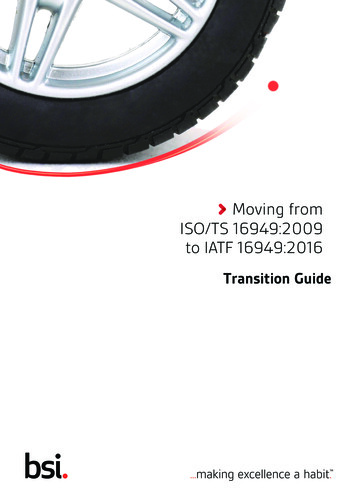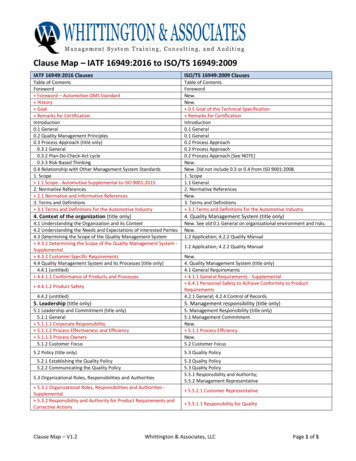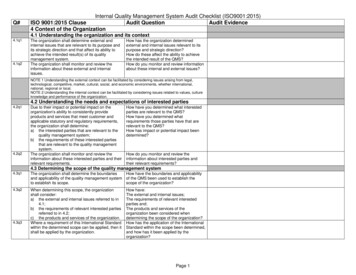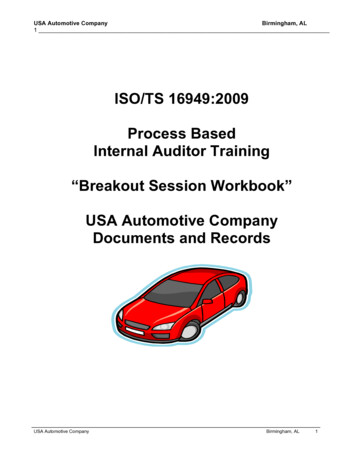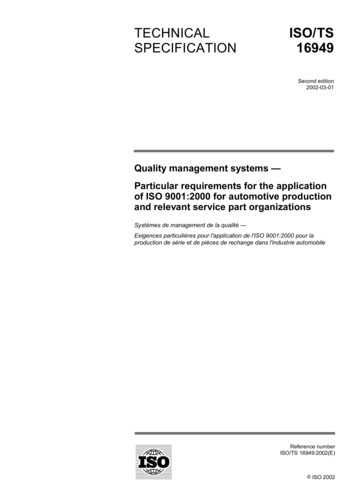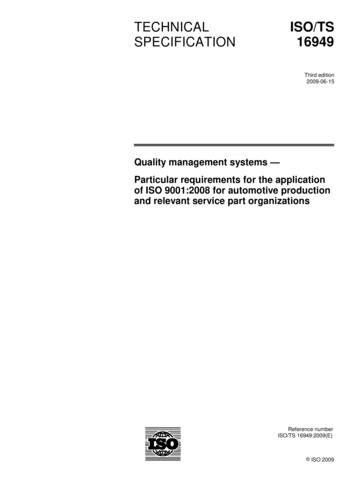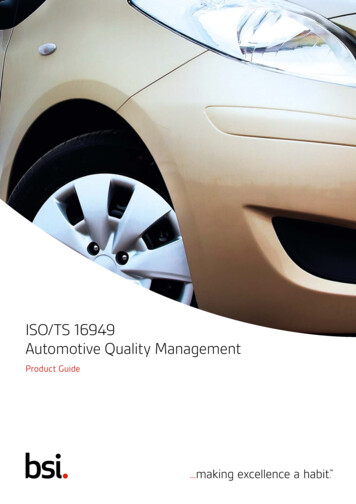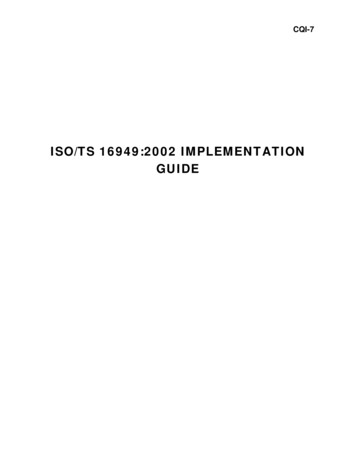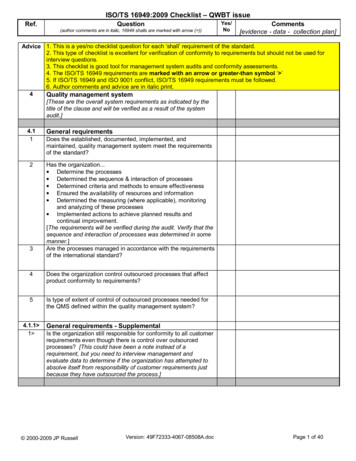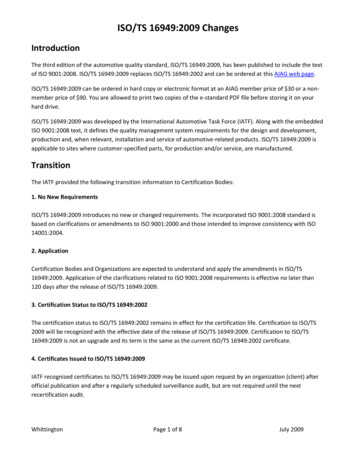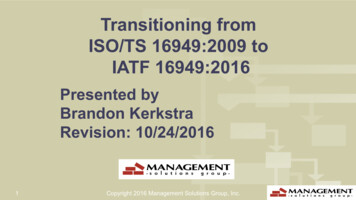
Transcription
Transitioning fromISO/TS 16949:2009 toIATF 16949:2016Presented byBrandon KerkstraRevision: 10/24/20161Copyright 2016 Management Solutions Group, Inc.
For Web TrainingTo Prepare for the training and to get the most out of thissession:1.Print a copy of the slides2.Follow along and take notes3.2Remember you have access to the course so you can referback if necessaryCopyright 2016 Management Solutions Group, Inc.
Thoughts for us to consider As we review the changes in IATF 16949:2016, think about thebest place in your QMS to implement the changes and how youmight verify the information in an audit:1.2.3.3How will this change your QMS or do you already cover?What are changes in the Objective Evidence that you wouldcollect?What processes in your organization could be improved?Copyright 2016 Management Solutions Group, Inc.
Presentation information 4Requirements that have significantly changed willbe identifiedRequirements that have been expanded will beidentifiedNotes that have become requirements will bereviewedCopyright 2016 Management Solutions Group, Inc.
Section 4.3.1: Determining the scope of thequality management system –IATF 16949 Section 4 (formerly sections 1.1 & 1.2):supplemental ––5Supporting functions, whether on-site or remote (such asdesign centers, corporate headquarters, and distributioncenters), shall be included in the scope of the QualityManagement System (QMS).The only permitted exclusion for this Automotive QMSStandard relates to the product design and developmentrequirements within ISO 9001, Section 8.3. Theexclusion shall be justified and maintained n 7.5).2016 ManagementSolutionsGroup,Inc.
Section 4.3.2: Customer-specificCustomer-specific requirements must be evaluatedrequirements and included in the scope of the organization'squality management system.6Copyright 2016 Management Solutions Group, Inc.
Section 4.4.1.1: Conformance of productsand processes 7The organization shall ensure conformance of allproducts and processes, including service partsand those that are outsourced, to all applicablecustomer, statutory, and regulatory requirements(see Section 8.4.2.2).The organization is responsible for the conformityof outsourced processesCopyright 2016 Management Solutions Group, Inc.
Section 4.4.1.2: Product Safety 8Documented processes for the management ofproduct-safety related products and manufacturingprocessesProcess must included, but not limited to (Whereapplicable) items on the next pageCopyright 2016 Management Solutions Group, Inc.
Section 4.4.1.2: Product Safety Identification by the organization of statutoryand regulatory product-safety requirements Customer notification of requirements above Special approvals for design FMEA Identification of product safety-relatedcharacteristicsIdentification and controls of safety-relatedcharacteristics of product and at the point ofmanufacture Special approval of control plans and processFMEAsReaction plans (see Section 9.1.1.1); 9Defined responsibilities, escalation process,flow of information, including top management,& customer notificationTraining identified by the org. or customer forpersonnel involved in product-safety relatedproducts & manufacturing processesChanges of product or process approved priorto implementation, including evaluation ofpotential effects on product safetyTransfer of requirements throughout thesupply chain, including customer-designatedsourcesProduct traceability by manufactured lot (at aminimum) throughout the supply chainLessons learned for new product introduction.Copyright 2016 Management Solutions Group, Inc.
Section 5.1.1.1: Corporate Responsibility ISO 9001: 2015 has increased the requirementsfor leadership by management.The IATF 16949 adds the following:–The organization shall define and implement corporateresponsibility policies, including at a minimum: 10Anti-bribery policyEmployee code of conductEthics escalation policyCopyright 2016 Management Solutions Group, Inc.
Section 5.1.1.2: Process effectiveness &efficiencyThe requirement to review processes to ensureeffectiveness and efficiency now encompasses: Top management shall review the productrealization processes and support processes toevaluate and improve their effectiveness andefficiency. 11Including the results of process review activities inCopyright 2016 Management Solutions Group, Inc.
Section 5.1.1.3: Process Owners Section 5.1.1.3 requires management to:––12Identifying process owners andAssure they are competent to perform their assignedroles.Copyright 2016 Management Solutions Group, Inc.
Section 5.3.1: Organizational roles,responsibilities, & authorities –This modified requirement now addresses thesupplemental 13need to:Document assigned personnel responsibilities andauthorities;Not only address – but MEET customerrequirements; andThis includes but is not limited to the selection ofspecial characteristics, setting quality objectivesCopyright 2016 Management Solutions Group, Inc.
Section 5.3.2: Responsibility and authorityfor product requirements and correctiveTop management shall ensure that:actions ––14–Personnel responsible for conformity to productrequirements have the authority to stop shipment & stopproduction to correct quality problemsPersonnel with authority & responsibility for correctiveaction are promptly informed of products / processesnonconformances to ensure that nonconforming productis not shipped to the customer, is identified andcontained2016 ManagementSolutions Group, inInc. charge of, orAll shifts areCopyrightstaffedwith personnel
Section 6.1.2.1: Risk AnalysisAdditional requirements for risk analysis now include: At a minimum, lessons learned from productrecalls, product audits, field returns and repairs,complaints, scrap, and rework. Retaining documented information (Records) asevidence of the results of risk analysis15Copyright 2016 Management Solutions Group, Inc.
Section 6.1.2.2: Preventive action Actions to eliminate the causes of potentialnonconformities to prevent their occurrenceAppropriate to the severity of the potential issues.Process to lessen the impact of negative effects ofrisk including the following:––16–Determining potential nonconformities and their causes;Evaluating the need for action to prevent occurrence ofnonconformities;Management Solutions Group, Inc.DeterminingCopyrightand 2016implementingaction needed;
Section 6.1.2.3: Contingency Plans This section requires the organization to define andprepare contingency plans. A systematicapproach should be taken to identify and evaluaterisk for all manufacturing processes, particularlyexternal risk.Contingency plans should be developed for:––17disruption conditions -- interruption of externally providedproducts, processes, and services, key equipmentfailuresCopyright 2016 Management Solutions Group, Inc.
Section 6.2.2.1: Quality objectives andplanning to achieve them – supplemental 18Ensure that quality objectives to meet customerrequirements are defined for relevant functions,processes, and levels throughout the organizationResults of the interested parties and their relevantrequirements review must be considered when theorganization establishes its annual (at a minimum)quality objectives and related performance targets(internal and external).Copyright 2016 Management Solutions Group, Inc.
Section 7.1.3.1: Plant, facility, andequipment planning Multidisciplinary approach including riskidentification and risk mitigation methods fordeveloping and improving plant, facility, andequipment plans. In designing plant layouts, theorganization shall:––19Optimize material flow, material handling, and valueadded use of floor space including control ofnonconforming product, andFacilitate synchronousmaterial flow, as applicable.Copyright 2016 Management Solutions Group, Inc.
Section 7.1.5.1.1: Measurement systemanalysis 20Statistical studies conducted to analyze thevariation present in the results of each type ofinspection, measurement, and test equipmentsystem identified in the control planAnalytical methods and acceptance criteria usedmust conform to MSA manualOther methods and acceptance criteria may beused if approved by the customer (Must haveCopyright 2016 Management Solutions Group, Inc.records)
Section 7.1.5.2.1: Calibration/verificationrecords 21Documented process for managing calibration /verification records.Records needed to provide evidence of conformityto internal requirements, legislative and regulatoryrequirements, and customer-defined requirementsCopyright 2016 Management Solutions Group, Inc.
Section 7.1.5.2.1: Calibration/verificationrecords 22Revisions following engineering changesOut-of-specification readings as receivedfor calibration/verification;Assessment of the risk of the intendeduse of the product caused by the out-ofspecification condition; M&TE with “AS-Found: calibration dataout of tolerance – records of evaluationof previous measurement resultsNotification to the customer if suspectproduct or material has been shipped; statements of conformity to specificationafter calibration/verification;verification that the software versionused for product and process control isas specified;records of the calibration andmaintenance activities for all gauging(including employee-owned equipment,customer-owned equipment, or on-sitesupplier-owned equipment);production-related software verificationused for product and process controlCopyright 2016 Management Solutions Group, Inc.
Section 7.1.5.3.2: External laboratory Org. assessments or second party are allowedwhen approved by customerCalibration requirements are increased toaccreditation–23the laboratory shall be accredited to ISO/IEC 17025 ornational equivalent and include the relevant inspection,test, or calibration service in the scope of theaccreditation (certificate); the certificate of calibration ortest report shall include the mark of a nationalCopyright 2016 Management Solutions Group, Inc.
Section 7.2.1: Competence – supplemental Document processes for identifying training needs“Awareness,” is a new requirement which wouldtypically include:– 24Quality policy, quality objectives, personnel contributionto the QMS, benefits of improved performance, andimplications of not conforming with QMS requirements.Focus on satisfaction of customer requirementsQualified for specific assigned tasksCopyright 2016 Management Solutions Group, Inc.
Section 7.2.2: Competence – on-the-jobtraining 25Provide on-the-job training (which shall includecustomer requirements training)Includes contract or agency personnelIncludes new or modified responsibilitiesInformed about the consequences ofnonconformity to customer requirements.Copyright 2016 Management Solutions Group, Inc.
Section 7.2.3: Internal auditor competency Organizations need to:––– 26Provide a documented process to verify competence(Including any customer specific requirements)Record a list of the approved auditorsApproved auditors competent on process approach, riskbased thinking, customer specifics, ISO 9001 & IATF16949, Core tools, Plan, report, close findingsThe clause differentiates between qualitymanagementCopyrightsystemauditors, manufacturing2016 Management Solutions Group, Inc.
Section 7.2.3: Internal auditor competency Maintenance of and improvement in internalauditor competence shall be demonstratedthrough:––27executing a minimum number of audits per year, asdefined by the organization; andmaintaining knowledge of relevant requirements – basedon internal and eternal changes (e.g. core toolsupdates )Copyright 2016 Management Solutions Group, Inc.
Section 7.2.4: Second-party auditorcompetency 28Requirements for second-party auditors areoutlined to ensure they are properly qualified toconduct those types of audits, with customerspecific requirements being a main focus.The same core competencies that apply to internalauditors should, at a minimum, also apply tosecond-party auditors.Copyright 2016 Management Solutions Group, Inc.
Section 7.3.1: Awareness – supplemental Maintain documented information thatdemonstrates that all employees are aware of theirimpact on:–––29The organization’s product quality outputCustomer specific requirementsRisks involved for the customer should non-conformingproduct be releasedCopyright 2016 Management Solutions Group, Inc.
Section 7.3.2: Employee motivation andempowerment 30This section now requires "maintain[ing] adocumented process(es)" for employee motivationand empowerment, instead of simply "having aprocess."Copyright 2016 Management Solutions Group, Inc.
Section 7.5.1.1: Quality managementQualityis a requirement for IATF 16949. ItsystemManualdocumentationcan be one main document or a series of multipledocuments (hard copy / electronic). Requirementsare: Scope & Justification for any exclusions References to the documented QMS processes Organization’s processes and sequence &interactions including type and extent of control of31Copyright 2016 Management Solutions Group, Inc.
Section 7.5.3.2.1: Record retention 32Define, document, implement a record retentionpolicyStatutory, regulatory, organizational, and customerrequirementsPPAPs, tooling records (including maintenanceand ownership), product and process designrecords, purchase orders (if applicable), orcontracts and amendments–Copyright 2016 Management Solutions Group, Inc.Kept for productionand service one calendar year
Section 7.5.3.2.2: Engineeringspecifications 33 Documented process describing the review,distribution, implementation of customerengineering standards/specifications – CustomerSchedulesWhen Spec changes design changes –reference ISO 9001 section 8.3.6When spec changes Process changes –reference ISO 9001 section 8.5.6.1Copyright 2016 Management Solutions Group, Inc.
Section 8.1.1: Operational planning andcontrol
As we review the changes in IATF 16949:2016, think about the best place in your QMS to implement the changes and how you might verify the information in an audit: 1. How will this change your QMS or do you already cover? 2. What are changes in the Objective Evidence that you would collect? 3. What processes in your organization could be improved?
